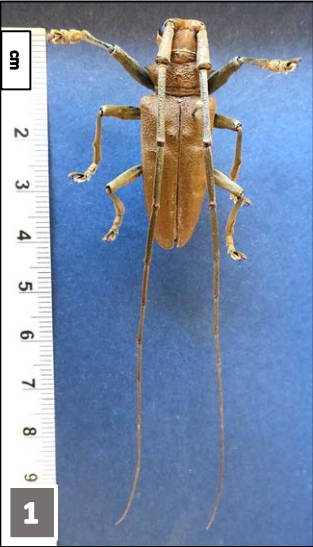LIHUE — Federal legislators are warning the nation about an invasive beetle that’s showed up on Hawaii Island, pointing to the potential for agricultural devastation should it make its way to the mainland.
That same potential goes for other islands in the archipelago too if biosecurity measures fail at airports or other points of entry.
The insect is the invasive longhorn beetle, which arrived on Hawaii Island in September 2013. Currently it’s contained to a small area on Hawaii Island, but it’s targeting trees of “significant cultural and economic importance,” according to the Hawaii Department of Agriculture.
That includes citrus trees, the Queen sago palm, cacao trees, breadfruit trees and kukui trees.
Based on observations in Hawaii, larvae of the longhorn beetle can cause extensive damage to trees by burrowing through their trunks, resulting ultimately in the death and physical collapse of affected trees, HDOA says.
Near the end of October, U.S. Sen. Brian Schatz called out Secretary of Agriculture Sonny Perdue and Secretary of the Interior David Bernhardt to step in and provide immediate support to efforts to control and eradicate the invasive longhorn beetle before it devastates Hawaii Island.
“The threat to U.S. agriculture and Hawaii’s environment justifies immediate, strong intervention from the federal government in order to prevent harm to the U.S. economy and federally managed lands in Hawaii — especially while the threat of A. Aesthetica (longhorn beetle) is still confined to a fairly limited area on Hawaii Island,” Schatz said.
Members of the Kauai Invasive Species Committee confirmed the invasive longhorn beetle is not yet known to be on Kauai, but could cause problems if it were to gain a foothold.
For example, the Kauai Breadfruit Institute at the National Tropical Botanical Garden has more than 120 breadfruit varieties in their living collection on Kauai that would be impacted should the beetle gain access to the trees.
“Federal land managers should act in coordination with the state, county, and private landowners to implement the practices identified by researchers to contain, mitigate, and hopefully eradicate A. Aesthetica,” Schatz said.
Schatz’ news release called the lack of knowledge about the beetles “alarming” and said more research is needed on basic things like their biology and ecology, with a focus on hosts; development of trapping and other monitoring tools; and understanding how they came to Hawaii in the first place.
KISC reminds anyone who thinks they’ve seen a longhorn beetle, or any other invasive and incipient species, to report it by calling 643-PEST.


